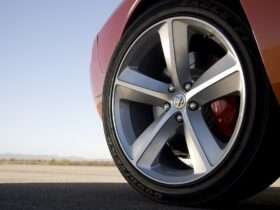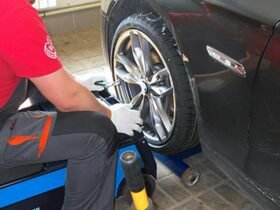Horiba of the world 
This is not a test: the technicians of the world are able to put cars through their steps, just like in the real world
The facility is more than just a testing ground - it is a global hub for new technologies in the automotive industry
If you thought that a fairly large part of the world as a test track in the middle mountains, you will not be alone. When it was seized by the Japanese firm Horiba in 2015, the first point telegraph called Nuneaton's "Test Car Track and Development Center, which served as the venue for the Top Gear Auto Show and Fifth Gear."
The track set was known to have been laid over the former RAF Lindley's runways and taxiways when it was re-designated to become a state-supported base by the Automotive Research Association in 1948. When Chairman Austin arrived to officially open the site, he brought a pair of ceremonial scissors, not knowing the MD planned to blow up the tape with explosives alone.
Then the world had several runways and taxiways, a control tower and one hangar. When I started visiting about 12 years ago, because that's where a car often does its performance tests, the ground floor towers were still where you signed up to use the tracks. And I'm sure the glass observation deck at the top was used by one employee in the greenhouse.

It's not like the world, including 1950s built labs and offices in front of the site, lacked work. There was so much in the container. But the place needed to spend hundreds of millions of pounds it didn't have on infrastructure.
Some came - the control tower moved to a new building, at least - but it needed more, so Mira began to announce itself to investors in the early decade and eventually found a suitable buyer in the Japanese company Horiba, who paid £85 million in 2015 year.
As an outsider - sometimes as an employee - unknown about the takeovers: did they withdraw assets? Will work go? Not in this case. It wasn't there. Investment since a long time.

Basically, Horiba manufactures high-precision testing equipment, all from spectrometers used on antiques to gas analyzers that detect hazardous elements in waste.
He has various test centers, including technical ones in Germany and the USA - and he has found a match in the world.
“Why do they want a bit of the old world?” asks the managing director of Horiba World, Declan Allen. “They wanted the application experience, and to be a long-term Japanese company, they saw us dealing with new technologies and thought that if they wrapped themselves around us, we have a future.”
The world's test chambers are now Buzz hum of Horiba's technology, but investment elsewhere is more surprising.

Testing still accounts for about 45% of business -- getting cars under the new WLTP rules has seen three of the world's Horiba emissions test cells run in three shifts, but "if you're only doing testing, you're vulnerable," says Allen.
Engineering development is 45% of the work, and the remaining 10% of the new technology park, where manufacturers and supplier outposts, and even in college, although Horiba world is not just a landlord. “We're all collaborating to make sure the new facilities are used,” Allen says.
The engineering estimate of the world has long been exposed to the world - part of the trouble is that a lot of clients don't like to talk about what's going on.
It has long been easier to say what the world cannot or does not want to do. It does not design a car, and it is not a mass production car. “If it’s 10 cars, of course,” says Allen, “50 maybe, but 5000, then the license is for that.” Beyond these limitations though, Horiba World has the ability to design and build everything, from start to finish, for a new car. Most manufacturers do not need, but only two years ago the world created a quick response warship a year.

But these days your ambitions are a little stronger. He would like to see that through the introduction of technology, it helps to develop, every journey in the world has a positive effect on us. And future technology is as important as what makes it on the roads today. “We are developing a research and development complex here,” Allen explains, from an office that overlooks a good fraction of 750 acres, including the old tower.
Here you can see the new city map, digital connection, so cars and base stations can communicate with each other. Currently being used to develop driver assistance and autonomous technologies and traffic management. Another new test track build has begun, including a 350-meter access road to a wide, 300m-diameter asphalt pad (given the go-ahead to some objections about its proximity to the Bosworth Field site), and more new construction to allow testing and development of autonomous parking technology.

“What's great about this site is that we have an enclosed part of our facility, then we have a semi-segregated part of the site, and then the connected and autonomous vehicle highway infrastructure approaches our doors,” explains Graham Stewart, Horiba World Technical principal, and then sit in the atrium of the Institute of Technology, a college that offers everything from professional courses to PhDs (and coffee, meetings, and electric car charging if you donate). In cooperation with local colleges and universities, and in eight months it was opened, it was signed by up to 3400 students.
Even producing the right engineers means it's part of the job. “I believe that the scale of the industrial revolution is happening in an industry that has been seen since the advent of self-propelled carriages,” Stewart says. “It's one of the fun things. One of the interesting things is that we will start working on many projects, from top-of-the-line luxury vehicles from tuk-tuks to unmanned ground vehicles for passenger car registration. We have the opportunity to shape the future of mobility.”
Vehicles developed in Mira

McLaren F1: The McLaren F1 set the world's fastest track record in the 1990s, managing a 168mph average and 192mph at the peak of its straights. The previous record was 161mph set by Jaguar XJ13 Prototype Racer

Enfield 8000: The energy crisis of the 1970s caused enough turmoil that the Enfield 8000 electric car was developed, in part by Mira. It made about 8bhp and can do almost 50mph. They weren't too successful, but our friend Johnny Smith upgraded a 'flux condenser' version running sub-10sec standing a quarter mile.

Lotus Bicycle: The world's climate chambers prepared adventurers for arctic expeditions and their wind tunnel helped refine the aerodynamics of a lotus bike made for Chris Boardman, on which he won the 4K pursuit at the 1992 Olympics.
Details
Fastest cars around the car handling scheme
Does semi-autonomous systems make cars safer?
How Bicester's legacy will become Britain's motorists
























REPLY